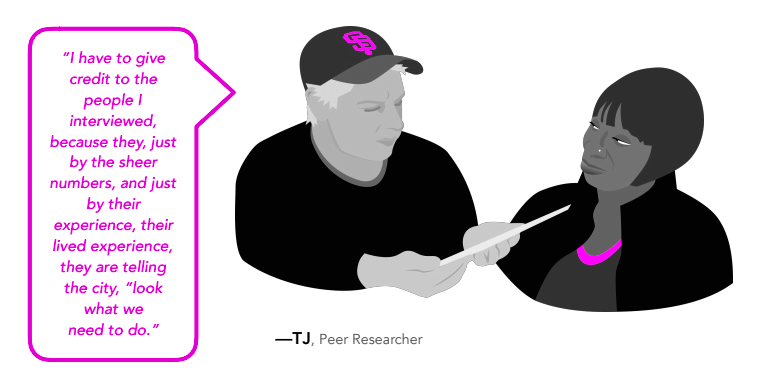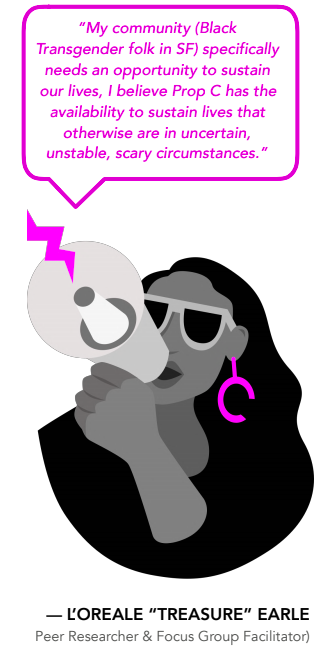
A new study from San Francisco’s Coalition on Homelessness (COH) produces policy recommendations based on an extensive survey of people experiencing homelessness in the city. The study, which is based on these surveys, was also conducted by unhoused San Franciscans. These unhoused surveyors received support and training from researchers at some of the nation’s most best universities, including the University of California at Berkeley, San Francisco State University, and Santa Clara University. The strategy of engaging unhoused people in research about homelessness has long been a hallmark of the work produced by COH, said Paul Boden, Director of the Western Regional Advocacy Project, which contributed to the study. “As an organizer you don’t say what the community wants, you don’t represent the community, you document what the community tells you. And you push for what the majority of them tell you they want to see happen,” said Boden, who is formerly homeless himself.
“When conducted in a non-obstructive manner, you can literally build a righteous social justice, human rights focused organizing base,” Boden said, “just by simply instituting a process where the organizers are accountable to the people.”
Researchers divided the report into chapters focused on various city systems that the unhoused rely on, including homelessness prevention, shelters, substance and mental health treatment, and the transgender experience of homelessness. 13 peer researchers surveyed 584 people currently experiencing homelessness in San Francisco. The study also included 25 one-hour focus groups, each with five additional participants. The interviews were thorough: researchers spoke to transgender people, to Spanish speakers at the Mission Resource Center, and in encampments throughout the city.
The study’s most significant takeaways are that the shelter system is a waystation between bouts of homelessness; that the idea that homeless people are service resistant is a myth; and that a housing-first strategy is the only way to fix the city’s homelessness crisis. The study’s principle finding is that the city’s homelessness services act as a “revolving door that churns people through, and too often, spits people back to the streets where they start over, with more trauma and less hope,” the study reads.
Proposed remedies include easier access to personalized case management, and the implementation of a support strategy that recognizes the intersectionality of factors like mental health needs, substance use, and gender identity.
Below are some of the specific findings and recommendations presented in the study.
San Francisco’s unhoused community was priced out of San Francisco
It is a common misperception that San Francisco’s homeless crisis is the product of unsheltered people being bussed into the city from out of town. In fact, the study found that 70 percent of survey respondents were housed in San Francisco at the time they became homeless. More than half of those respondents who were housed in San Francisco before becoming homeless reported that they’d been living in the city for ten years or more. A quarter of those surveyed became homeless in the past year. Most were priced out of their homes, with people who have been in Government-supported housing disproportionately impacted. The most common reason for losing housing was an inability to pay rent, most often due to job loss, low-income employment, or personal issues.
San Francisco’s unhoused community wants to access supportive services

In 2019, the Point in Time survey of the city’s homeless residents counted over 9,000 unhoused people in the city. The same night, shelter capacity within the city was only 3,400 beds. That same year, an average of 1,200 a day people waited on the single adult shelter waitlist.
Most people experiencing homelessness have tried to stay in shelters, according to the study. 81 percent of those surveyed had used or tried to access shelters in the past. Half of that group had tried within the past year. This bucks the notion that unsheltered people are ‘service resistant,’ and highlights the way narratives around homelessness tend to blame the unhoused. “Each system is setting up an intake process that is designed to screen you out of eligibility. And so [case managers], they’re trying to make sure that you’re not eligible, and you’re trying to prove that you are,” Boden said.
The services provided at homeless shelters that most respondents said they want to see more of are access to food, hygiene products, and case management. Case management is critical for those navigating city services, the study said.
Respondents said they would rather sleep in a shelter than on the street
A majority of respondents said they felt more stable in a shelter rather than on the street. This also pushes back against the notion that unhoused people are service resistant. They cited better sleep, better physical health, better access to food and other services. But many considered shelter living to be damaging to their health, safety, privacy, dignity or efforts to become housed. Feeling safer in a shelter than on the street is less common among trans respondents.
Finding and accessing resources can be confusing, and once folks are enrolled in a shelter or supportive program, the care provided can be culturally insensitive, unnecessarily restrictive, or inappropriate for the person who needs help. This was raised in many of the focus groups conducted, with most of the concerns coming from non-English speakers, the LGBTQ community and older adults.
A third of respondents reported having their belongings confiscated at a shelter in the past five years. The most common items taken were personal belongings, weapons, drug paraphernalia, and camping equipment.
Stable housing is the best thing for mental health and substance use issues
88 percent of respondents said stable housing is crucial in meeting their treatment goals, and that treatment would “prove pointless” without stable housing.
Half of respondents reported they would be more likely to remain in treatment if substance use is permitted, while the other half reported abstinence programs would be better for them. This data conveys both substance use treatment plans should be available.
Solutions
Policy recommendations
The study includes many policy recommendations, some of which may be surprising to those without firsthand experience navigating San Francisco’s support systems. The recommendations include pushing for better tenant protections on the state level by taking steps like repealing the Costa-Hawkins Act and the Ellis Act, which make evictions easier and tenant protections harder; encouraging the state to assert housing as a human right; breaking down barriers to supportive housing such as the exclusion of those with debt and criminal records; increasing the stock of public housing to match the current need; and increasing rental assistance to keep people housed, which is ultimately cheaper for the city.
Shelters and supportive services
The study also recommends San Francisco diversify its substance use support offerings to include harm reduction in addition to abstinence-minded strategies, and offer both sober shelters and shelters for those safely using drugs and alcohol. The study suggests that substance use issues and mental health issues ought to be considered in tandem, for neither treatment can succeed without the other. Substance use treatment should be trauma-informed, and the city needs to develop a targeted approach to stimulant use issues, which are on the rise.
The city must also better track data in supportive housing, in shelter bed availability, and in outcomes. The city should track gender identity when collecting data on evictions and voluntary departures from supportive housing. Shelters should get rid of curfews and stay limits. They should offer healthy food 24 hours a day, off-site storage and intensive in-house case management.
Adopting an LGBTQ+ inclusive framework
Survey respondents also highlighted the need for San Francisco to establish safe spaces for trans people experiencing homelessness, including trans-friendly shelters and supportive housing. Many trans respondents reported feeling safer and more welcome when working with trans-specific organizations. Mental health and substance use treatment should be gender-affirming, and the wider support system for the unhoused should move away from binary gender classifications, the study suggests.
How this study is different
The study encourages readers to pay special attention to its recommendations because it is based entirely on the input of impacted people, who are treated in the study as “decision makers and leaders of homelessness policy.” When their voices are heard, the study says, “you will hear their suffering, but also their brilliance.
“It will not be easy, it will take work,” the study says. “But in these pages you will hear about what changes are needed directly from the true experts—those experiencing the hellscape of homelessness.”
In the data: mental health and substance use
• 71% said they would prefer a dedicated clean and sober shelter, 24 percent said they would prefer a shelter where they could safely use drugs. Respondents were almost evenly split when asked if they would like to see safe injection spaces within shelters.
• 60% of those surveyed reported experiencing a mental health crisis in San Francisco in the past 5 years. More than half of those who haven’t received treatment cited access issues.
• 60% of those who reported mental health issues believe mental health treatment would require substance use treatment to be effective.
• Of respondents who reported mental health issues, over 90% said stable housing would be critical to the success of their treatment. Only 9% reported moving into stable housing after treatment, compared to the 63% who reported they were unhoused or lived in a city shelter after their treatment.
• 72% of those who received mental health treatment said it helped them.
• There are barriers to accessing substance use treatment, but for those who get treatment, positive short-term changes were reported.
• There’s a massive demand for mental health services, but most experiencing homelessness in San Francisco don’t have access to these services.
• A third of respondents reported substance use issues. Half of that group remains untreated. Of those who received treatment, 80% were totally or partially successful at meeting their goals. Many said their treatment program was too short.
• Two-thirds of respondents said after substance use treatment they returned to the streets. 88% said stable housing is crucial in meeting their treatment goals.
• The majority of respondents who received treatment were unhoused while undergoing that treatment, and 46% report living in the streets after treatment.
In the data: the shelter system
• One in five respondents had been evicted, disproportionately from public housing.
• One third of respondents said that rental assistance would have kept them housed. The vast majority of those respondents believe they would have only needed rental assistance for a year or less.
• 70% of trans respondents who reported using shelters left because of discrimination or violence from staff.
• Trans respondents were more than three times more likely to lose housing due to domestic violence than the general sample.
• 30% of those who had spent time in shelters reported leaving after mistreatment, either by choice or by force. More than a third of those respondents left due to a conflict with staff.
• Close to one-third had to leave a shelter against their will due to stay limits.
• 58% of respondents said they’d prefer a legal encampment to a traditional shelter. This includes half of cisgender women, 60% of cisgender men and about two thirds of trans respondents.
• 64% reported they tried to access shelter space but were turned away due to a lack of available beds.
• For those who had not stayed in a shelter in the past five years, the most common reason cited was the shelters system’s bad reputation, followed closely by a previous bad experience at a shelter.
• About three quarters of respondents would take advantage of case management if it was offered.
Daniel Lempres is a freelance reporter based in Oakland. He focuses on local government, policing and housing policy. He’s contributed to the East Bay Express, Berkeleyside and the Humboldt Times-Standard. Daniel is a Master’s Candidate at UC Berkeley’s Graduate School of Journalism.
